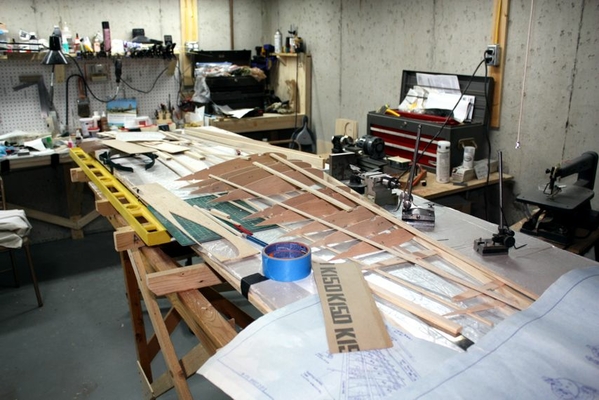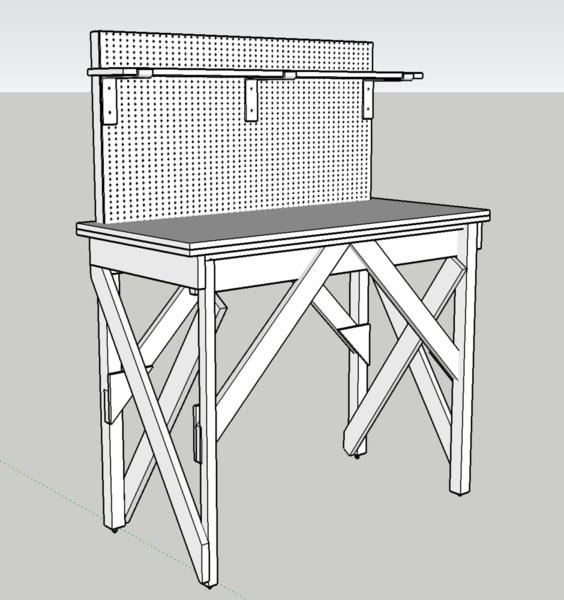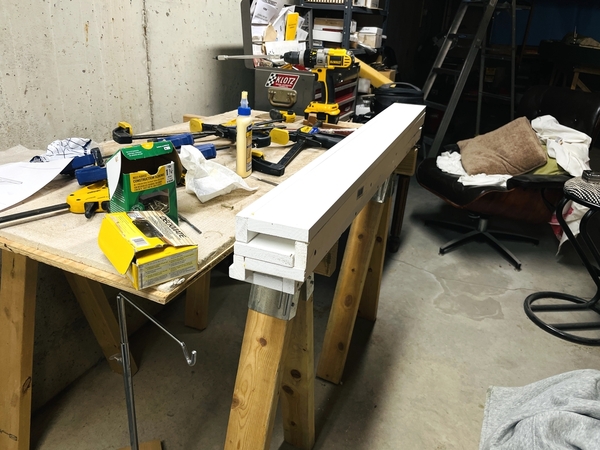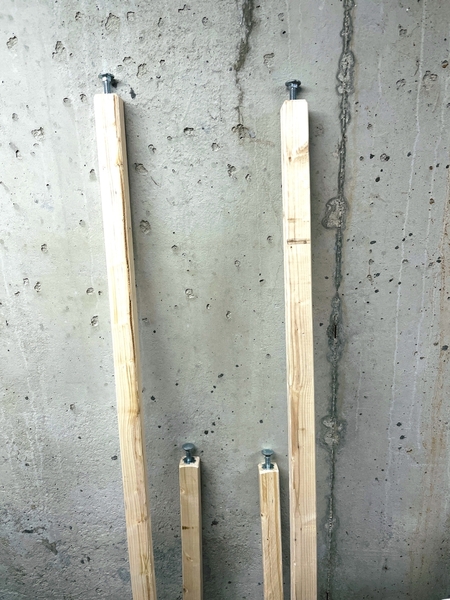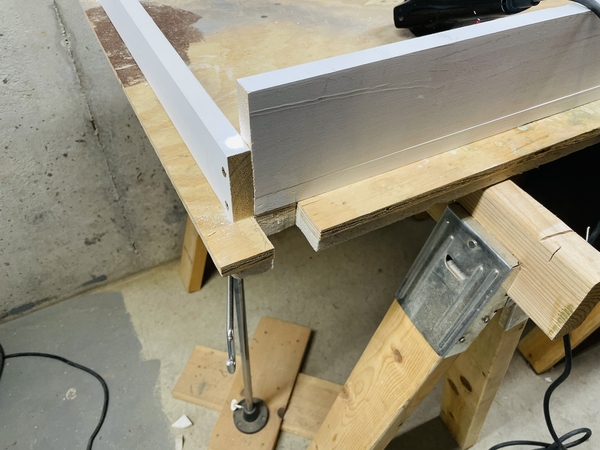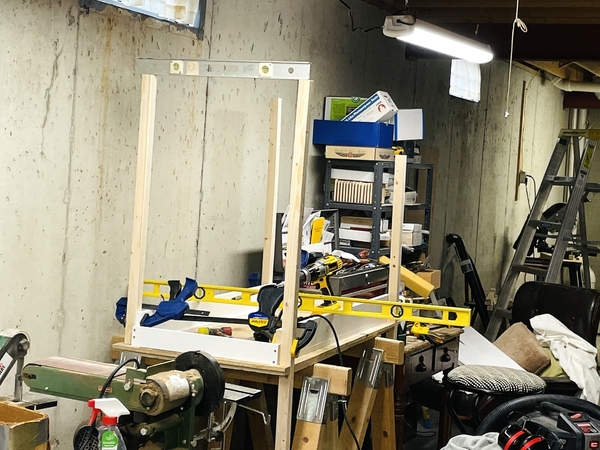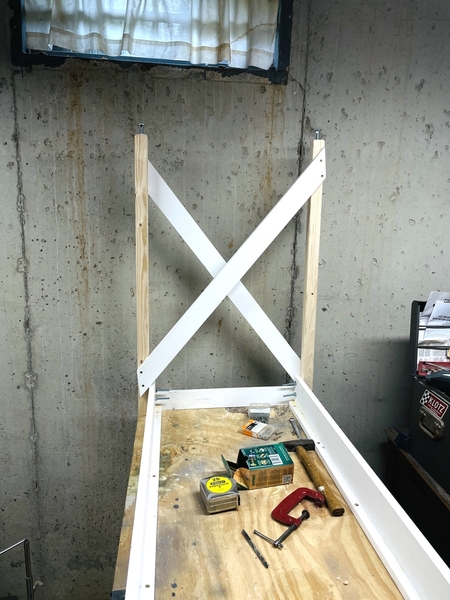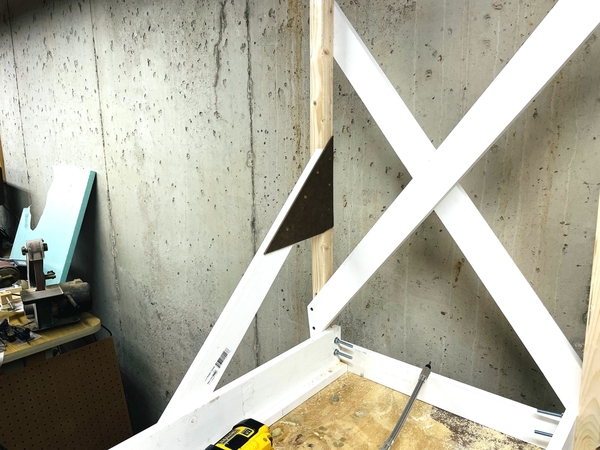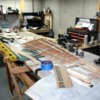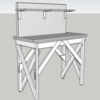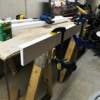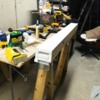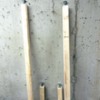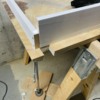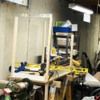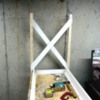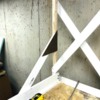I produced a post last night, but neglected to hit SEND and therefore, lost the entire deal. Now I'll do it again. Ugh!
While this is technically not a train issue, since I'm using L-girder construction to do it, and since I've posted literally everything that's happened in my life for the last 9 years, I am declaring it legitimate to post on my never-ending story.
The project is to finalize the upgrading of two work surfaces that have been sitting on saw horses since layout construction ended in 2014. I created the work surfaces to for building the large main wing of the 1:16 scale RC B-17 that I finished in 2011. They consisted of a 1/2" piece of plywood capped with a layer of homosote. The resulting surface was perfect for holding T-pins which were holding the balsa parts of the big wing. At the time, they were supported on an L-girder frame that eventually was re-sized and re-purposed as the end platform area that forms the tunnels and area in front of the gate.
Here is the table in used in building the B-17's 6 foot wing.
For the past 7 years this table and its twin were in the railroad room and it's where I did the sloppy work like plastering. They sat on rickety saw horses that were not stable and a pain in the butt to sweep around. You've seen these tables in use over the past years, for instance when I was gluing up the sides pilasters on the engine house. Like here: You can see the lovely saw horses.
I moved one of the pair, a 4' X 2' chunk into the shop are still with its saw horse base, but wanted to upgrade it to a real, substantial and stable work surface. Right now it was holding my three sanding machines. I want to move all the 3D printing stuff to this table and move the sanding equipment to the current 3D table. My reason… I'm going to improve the bench with a back pegboard and a shelf so all the printing paraphernalia can go on the shelf and only the operating equipment will be on the work surface.
It's going to look like this:
Since I find that L-girder is so solid, I decided to use it in making this table structure. The girders are 4' long minus 2X the board thickness on each end which worked out to 42-1/2" long. The front legs stop at the girder top. The rear legs continue through a slot in the table top to 2 feet above the working surface for the peg board side supports. My peg board is left over from making the original work benches in 2010. I have enough for this bench and making a permanent surround for the model making table so my small tool racks are mounted on the board and not taking up precious work top space.
I covered making L-Girder a long time ago in the layout building thread, but instead of forcing anyone wanting more information to go back into the archives, I'll give a quick review here.
The web (the vertical part) is a 1 X 4, and the flange (the horizontal part) is a 1 X 2 are glued together with Titebond II wood glue. The steps are: Cut the members to length (in this instance 42.5"), and clamp them together with Quickie Clamps. Doing it on a set of saw horses works because you can also clamp the assembly to the horses to keep everything still. Drill holes for some screws that will temporarily hold the web and flange together while glue dries so you can remove the clamps and use them on the next girder. Back the screws out so the two parts can separate, apply a bead of glue to the web's edge, and then screw them back together so the glue oozes out of the joint. The next day, you can remove the screws and reuse them to build other stuff. The screw ONLY hold the parts until dry. The glue joint is immensely strong.
This picture shows the initial clamping. You can see that one is holding onto the saw horse also.
Here were the four girders needed to upgrade both benches. The screws haven't yet been removed.
That was yesterday's work. Today, got one bench almost finished. I cut the legs, their leveling screws, L-girders and legs, attached and made a great start on all the diagonal bracing that makes this whole thing work. You can use 2 X 2 legs as long as they're deeply braced. Because of the short table, the bracing isn't as deep as I would like, but since this isn't having to hold the weight of all the trains and the 180 pound guy that occasionally has to climb on the table, it will be quite strong.
I wanted the working height to be the same as the taller parts of my main workbench, 36". I subtracted the table thickness and some more to account for the #10 metric carriage bolts and T-nuts so the feet can be precisely leveled. The 3D printed needs to be level and cross-level. It really helps to have a level work surface at the start. The back legs had to go up that additional 2 feet for the back board. Some of the 2 X 2s I got from Lowe's were bent like pretzels. I can use some. As it is I way over-estimated the amount of leg stock I would need. "Why Metric carriage bolts?" you ask. I had a bunch left over from the original layout building in Germany in 1999. As it was it was $140 for the lumber without that hardware. I did have to buy the metric T-nuts, and realize that I will also need #10 nuts so the adjustments can be locked.
After marking the center of the table top, and the girder centers, I positioned them for attachment. I cut a small chunk of the leg stock to use as a gauge since the rear legs were mounting flush against the table's edge in the back and front. I set the gauge at the edge and positioned the girder against it and then drew a line the length of the girder on the table bottom. I screwed the girder down by drilling through the web with a wood screw drill. I use Torx drive screws exclusively. I'm particular to SPAX. They are marvelous screws that I started using in Germany. They're now available here at THD. Torx screws DON'T CAM OUT, and you don't need to apply excessive down force to keep the driving head engaged.
I attached and end board 2 X 3 to further stabilize the girder and you can see the relief cut where the back leg will pass through the table. I used my saber saw to make that cut.
I temporarily clamp the short front legs and then went about setting the tall rear ones. I wanted the legs to be be close to the same level, even though the leveling feet will adjust for any level error. I placed a long level on the leg tops and raised or lowered to match the front.
I also got the legs in plumb as best as I could. Their all a little warped so plumb was an approximation. After the legs were set on one end, I drilled through the leg and the girder and used 1/4" carriage bolts on the outside with nuts and washers inside. I ordered these, but they're WAY TOOOO LOOOONNNNG. I may use an abrasive cutoff wheel to shortened them. Or not. You really won't interact with them.
You can see the long screws in this image. I also started adding the X bracing. The end bracing is straight forward since they lay directly on the legs.
The long braces are different. It you screw them flat on the girder, they butt against the legs. If you want to screw them flush on the legs you need to pack out the to attach them to the girder. So you need to use gussets. The gusset attaches the brace to the leg so the brace can butt up to the leg. It's better than attempting to drill and screw on the brace's angle.
Tomorrow I should pretty much finish the first table.




